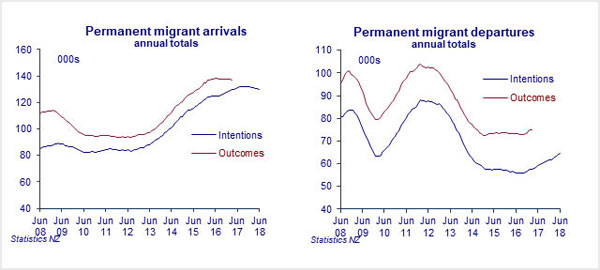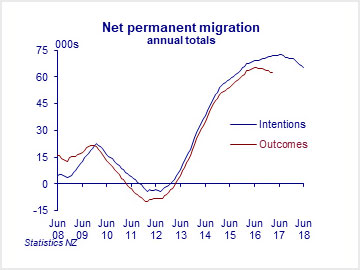With New Zealand Customs announcement of the removal of departure cards from November 2018, there will be a focus on the new migration measures produced by Statistics New Zealand that will replace the current measure. The current migration measure is based on the information from travellers on their intended length of stay in New Zealand recorded on the cards. To be a permanent migrant into New Zealand you need to intend to stay for at least 12 months, otherwise you are defined as a short-term visitor to New Zealand.
Statistics New Zealand moved in 2015 to produce a secondary measure of migration based on traveller’s outcomes. This measure used information from New Zealand Customs on the actual length of stay in New Zealand of travellers. Under this measure anyone who stayed in New Zealand for at least 12 months across a 16 month period was classed as a permanent migrant while the remainder were classed as short-term visitors. This approach is more accurate than the intentions based measure currently used. The main drawback of this measure is that Statistics New Zealand is only able to produce statistics 17 months in arrears.
Therefore Statistics New Zealand has decided to replace the current migration measure with a probabilistic predictive model of travel type (short-term arrival or permeant migrant) based on the characteristics of travellers. Under this approach the modelled estimates will be revised once the accurate outcomes based measure has caught up, meaning the last 17 months of data will always be a modelled estimate, while older data will be actual observed counts of migration.
The following three graphs show permanent migrant arrival and departures, and net permanent migrations using both the intentions based migration measure, and the new outcomes based measure, across an eight year time period from June 2008 to June 2018 using annual totals.

The graphs show that the intentions measure of migration has undercounted the number of permanent migrant arrivals and migrant departures over the last eight years, while the net permanent migration over the period is very similar between the two measures of counting permanent migration.
The graphs also show the gap between the two measures end points that is derived the length of time required to produce the outcomes measure, with the outcomes measure only available to March 2017 currently. This is the gap Statistics New Zealand’s new probabilistic predictive model will need to fill once the departure cards are removed in November 2018.
Overall this means that with the new outcomes measure of migration New Zealand will have a more accurate count of permanent migration, at the cost of some timeliness. Statistics New Zealand’s move to modelled estimates to provide a timely up-to-date migration measure will fill the 17 month gap between the intention and outcomes measures.
The questions for researchers and policy makers using migration data in the future will be:
- How important is timely migration data?
- How good will Statistics New Zealand’s model be at picking up changes in trends?
- Is the removal of the burden on travellers of removing the cards and the reduction in processing costs worth the potential reduction in the robustness of a timely migration measure?
